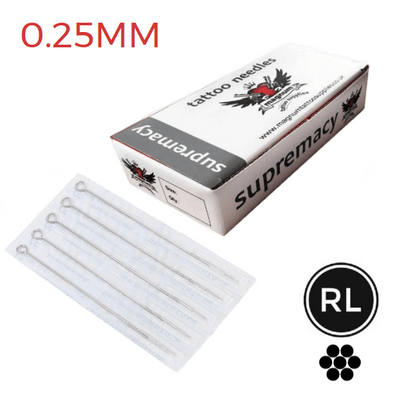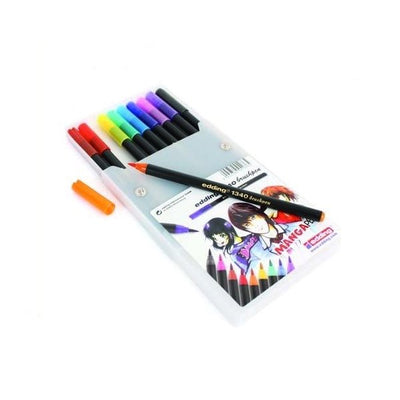Getting a tattoo is an exciting experience, but let's be honest—pain is part of the deal. Tattoo numbing sprays are a popular option for reducing pain, but with so many types and safety concerns, it's easy to get overwhelmed.
We'll break down everything you need to know about tattoo numbing sprays, from the different types available to their safety and effectiveness.
What is a tattoo-numbing spray?

A tattoo numbing spray is a product that tattoo artists use to help reduce the pain of getting a tattoo. It contains active ingredients like lidocaine or benzocaine, temporarily numb the skin's surface.
The spray works quickly, making it ideal for short sessions or to reapply during longer tattooing sessions. It's applied directly to the skin before or during the tattoo process, offering relief from the needle's discomfort.
However, it's important to use it as directed and confirm that clients aren't allergic to its components.
Types of tattoo numbing sprays
Lidocaine-based sprays
- Description: Lidocaine is a common local anaesthetic used in various topical ointments and sprays. It blocks nerve signals in the skin, providing a temporary numbing effect.
- Common concentrations: Typically ranges from 2% to 5%.
- Usage: Lidocaine sprays are applied shortly before the tattooing begins and can be reapplied during the session if the effect wears off.
- Popularity: One of the most widely used types due to its effectiveness and relatively quick onset of action.
Tetracaine-based sprays
- Description: Tetracaine is another potent local anaesthetic, similar to lidocaine, but generally considered stronger and longer-lasting.
- Common concentrations: These are usually found in lower concentrations due to their strength, often around 2%.
- Usage: Because of its potency, tetracaine is used where prolonged procedures are anticipated.
- Considerations: It may not be as commonly available as lidocaine but is favoured for longer tattoo sessions.
Benzocaine-based sprays
- Description: Benzocaine is a local anaesthetic that provides surface-level numbness and is less potent than lidocaine or tetracaine.
- Common concentrations: Often found in concentrations ranging from 10% to 20%.
- Usage: Typically used for shorter procedures or by those who have allergies or sensitivities to other anaesthetics.
- Considerations: Benzocaine's effects are more superficial, making it less effective for deeply painful procedures.
Combination formulas
- Description: These sprays combine two or more anesthetics to take advantage of the unique properties of each. For example, a spray might combine lidocaine and tetracaine to provide both rapid onset and prolonged numbing.
- Common combinations: Lidocaine with tetracaine, benzocaine with lidocaine, etc.
- Usage: Used for varying lengths and intensities of tattoo sessions, offering flexibility in pain management.
- Benefits: The combination can reduce the required concentration of each anaesthetic, potentially decreasing side effects while maintaining effectiveness.
Proper application of tattoo numbing sprays

Step 1: Clean the area
Before applying the numbing spray, thoroughly clean the area where the tattoo will be placed. Use mild soap and water to remove any dirt, oils, and lotions, which can interfere with the effectiveness of the numbing agent. Ensure the skin is dry before proceeding to the next step. This step helps in achieving the best possible results from the numbing spray.
Step 2: Apply the numbing spray
Shake the bottle well, then hold it a few inches away from the skin. Spray a generous amount directly onto the area to be tattooed, ensuring even coverage. Avoid spraying too close to the skin to prevent over-saturation, which can lead to runoff and uneven numbing effects.
Step 3: Allow time for activation
Give the spray some time to activate; this usually takes about 10 to 15 minutes. The time needed can vary depending on the spray's formulation, so refer to the product's instructions for specific details. During this time, the active ingredients work to numb the skin deeply enough to block pain from the tattooing needles.
Step 4: Test the skin's numbness
After the activation period, lightly touch the area to check for numbness. You should feel minimal to no sensation. If the area still feels sensitive, it's okay to apply a little more spray, but wait a few additional minutes for it to take effect. It's crucial not to start the tattooing process until the skin is adequately numb.
Step 5: Begin the tattoo procedure
Once the area is numb, you can begin the tattooing process. Be aware that the numbness will last for a limited time, often up to a couple of hours, depending on the spray used. For longer sessions, you may need to reapply the spray following the same steps, ensuring not to overdo it and always following the manufacturer's guidelines.
Step 6: Monitor and reapply if necessary
Throughout the tattoo session, keep monitoring the level of numbness. If you notice the effect wearing off, and the product label permits, reapply the spray following the same initial steps. Always ensure that the skin is wiped clean before any reapplication to avoid interaction with ink or other products.
Pros and cons of using numbing sprays
Numbing sprays can be a helpful aid in various situations, from medical procedures to cosmetic applications like tattooing. Here's a breakdown of the pros and cons of using numbing sprays:
Pros
Pain relief: The primary benefit of numbing sprays is their ability to temporarily relieve pain by numbing the skin's surface. This is especially useful during procedures that can cause discomfort or pain.
- Ease of use: Numbing sprays are simple to apply. They don't require any special preparation and can be applied directly to the skin.
- Quick Action: Many numbing sprays act quickly, often beginning to numb the area within a few minutes of application, which is beneficial in situations where immediate pain relief is needed.
- Minimal invasion: Unlike injections, numbing sprays are non-invasive. This minimises the risk of infection and avoids the discomfort of needle use.
- Controlled application: Sprays allow for a controlled application, meaning you can limit the numbing effect to just the area where it's needed without affecting surrounding areas.
Cons
- Temporary effect: The numbing effect of sprays is only temporary. Depending on the active ingredients and concentration, the effect may last only a short while, necessitating reapplication for longer procedures.
- Potential allergic reactions: Some people have allergies to the active ingredients in numbing sprays, such as lidocaine. This can cause reactions ranging from mild irritation to severe allergic responses.
- Uneven numbing: Depending on the spray and how it's applied, the numbing effect can be uneven, which might not provide sufficient pain relief for sensitive procedures.
- Ineffectiveness on deeper tissues: Numbing sprays are most effective on the surface of the skin and may not be as effective for pain originating from deeper tissues.
- Overuse risks: Overusing numbing sprays can lead to side effects such as skin irritation, increased heart rate, dizziness, and, in rare cases, more severe health issues like methemoglobinemia, especially with sprays containing benzocaine.
What to look for when choosing a tattoo numbing spray

Active ingredients
- Lidocaine: Most effective numbing sprays contain lidocaine, a local anaesthetic that temporarily blocks nerve signals.
- Benzocaine or Tetracaine: Other commonly used anaesthetics, though less effective for tattoos than lidocaine.
- Concentration: Lidocaine concentrations typically range from 2% to 5%. Higher concentrations may offer stronger numbing but could increase the risk of side effects.
Application time
Some numbing sprays are fast-acting (around 10-15 minutes), while others may take 30 minutes or longer to take effect. Consider how much time you have before your tattoo session.
Duration of effect
Check how long the numbing effect lasts. The spray must provide enough relief throughout the tattoo session, which can vary in length depending on the tattoo's size and complexity.
Skin sensitivity
Ensure the spray is suitable for sensitive skin. Check for any irritants or allergens in the ingredients, especially if you have reactive or sensitive skin.
Hypoallergenic formulations may be ideal for those with skin allergies or sensitivity.
Ease of use
Spray vs. Cream: Sprays are generally easier to apply evenly across large areas, while creams may be better for smaller tattoos. Consider which format is most convenient for your needs.
Absorption: Some sprays require a second application or additional steps like covering the area with plastic wrap to enhance absorption.
FDA approval
Ensure the product is approved or regulated by a health authority like the FDA or similar organisations in your region to ensure it's safe for use.
Tattoo-specific products
Look for numbing sprays specifically designed for tattoos, as these are often formulated to work better for prolonged skin trauma caused by the tattooing process. Products not specifically intended for tattoos may not provide lasting relief.
User reviews & recommendations
Check online reviews from other tattoo enthusiasts or professionals. Real-world experiences can give you insight into how well a product works and any potential side effects.
Ask your tattoo artist for recommendations, as they may have experience with certain products.
Price and availability
Numbing sprays vary in price. Consider the cost in relation to the product's effectiveness and the size of the tattoo. Keep in mind that cheaper products may be less effective or come with unwanted side effects.
Side effects and risks
Overuse or high concentrations of lidocaine or other numbing agents can lead to side effects like skin irritation, dizziness, or allergic reactions. Always follow the usage instructions closely.
Can you put numbing spray on a fresh tattoo?
It's generally not recommended to apply numbing spray on a fresh tattoo. The tattooed skin is an open wound, and applying numbing spray can interfere with the healing process. Some sprays contain alcohol or other ingredients that can cause irritation and drying, potentially leading to poor healing and affecting the tattoo's appearance.
How long does numbing spray last?
The duration of the effect from numbing spray depends on the formula, but it typically lasts between 30 minutes to a couple of hours. The active ingredients, such as lidocaine, are designed to temporarily block nerve signals, and the effect diminishes as the body metabolises these chemicals.
What happens if you use too much numbing spray?
Using too much numbing spray can lead to several adverse effects. It might cause skin irritation, redness, and swelling at the application site. Systemic effects could include a rapid heart rate, dizziness, confusion, and, in severe cases, respiratory difficulties.
Which is better, tattoo numbing cream or spray?
The choice between numbing cream and spray depends on the specific use and personal preference. Numbing creams often provide a longer-lasting effect than sprays and can be more suitable for prolonged procedures like tattoo sessions.
Sprays, however, are easier to apply and act faster, making them ideal for quick and less invasive applications. Both forms can be effective if used correctly and chosen based on the needs of the procedure.
How do numbing creams work?
Tattoo-numbing creams work by temporarily blocking the nerve signals in the skin to reduce the sensation of pain during tattooing. These creams typically contain ingredients like lidocaine, which is a local anaesthetic that numbs the area where it's applied. The cream penetrates the skin and desensitises the nerves for a few hours, making the process less painful.
In addition to tattooing, numbing creams are also used for laser hair removal and other cosmetic skin treatments like microblading or chemical peels, where pain relief can help make the procedures more comfortable for the patient.
Final thoughts
To wrap it up, tattoo numbing sprays can help make your tattoo session more comfortable, but it's important to choose the right one and use it safely.
Looking for the best tattoo supplies? Check out our website for top-notch tattoo machines, inks, and aftercare products. Whether you're an artist or just starting out, we've got everything you need to make your next tattoo a great one.



























































 Studio supplies
Studio supplies












 Power & batteries
Power & batteries








 Aftercare
Aftercare





















 Apprentice
Apprentice


 Piercing & jewellery
Piercing & jewellery







 PMU supplies
PMU supplies




 New arrivals
New arrivals
 Gift vouchers
Gift vouchers
 Shop all
Shop all















































